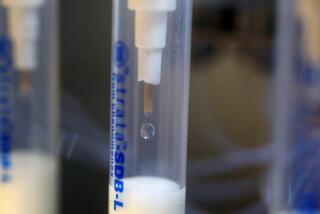Artificial sweeteners found in river water and drinking supplies

- Share via
Canadian researchers think they have found a great way to trace the travels of treated sewage after it is discharged into rivers: Follow the artificial sweeteners.
The scientists found elevated concentrations of four sweeteners - cyclamate, saccharin, sucralose, and acesulfame – in water samples collected along the length of the Grand River in Ontario, Canada.
Commonly used in diet drinks, the sweeteners got into the Grand by way of the 30 sewage treatment plants that empty into the river and its tributaries.
The research, detailed in a paper published Dec. 11 in the online journal PLOS ONE, adds to a growing body of evidence that people are spiking waterways and their drinking supplies with an array of compounds that pass through not just them, but even advanced treatment systems.
Antidepressants, antibiotics, steroids and fragrances are among the products that have been detected in surface waters. Some of the contaminants have been found in fish tissue. Some compounds not only get through sewage plants, they also survive purification of drinking supplies and have been measured in trace amounts in municipal tap water.
That was true of the sweeteners, which were detected in samples collected from homes in cities that draw supplies from the Grand, which empties into Lake Erie.
The researchers, from Environment Canada and the University of Waterloo, sampled the Grand at 23 locations along more than 150 miles from the river’s headwaters to its mouth.
They found lower concentrations of cyclamate and saccharin than acesulfame and sucralose, which are tougher to remove.
Acesulfame proved to be especially persistent. It was measured in elevated concentrations along the river’s entire length. That, the paper’s authors concluded, makes it the best candidate for tracing wastewater contamination.
The researchers made no attempt to gauge the ecological effects of sweetening a river, which they said are largely unknown.
But, they wrote, “We demonstrate here that aquatic organisms likely experience long-term exposure to significant concentrations” of artificial sweeteners if they are downstream of urban wastewater discharges.
Twitter: @boxall







